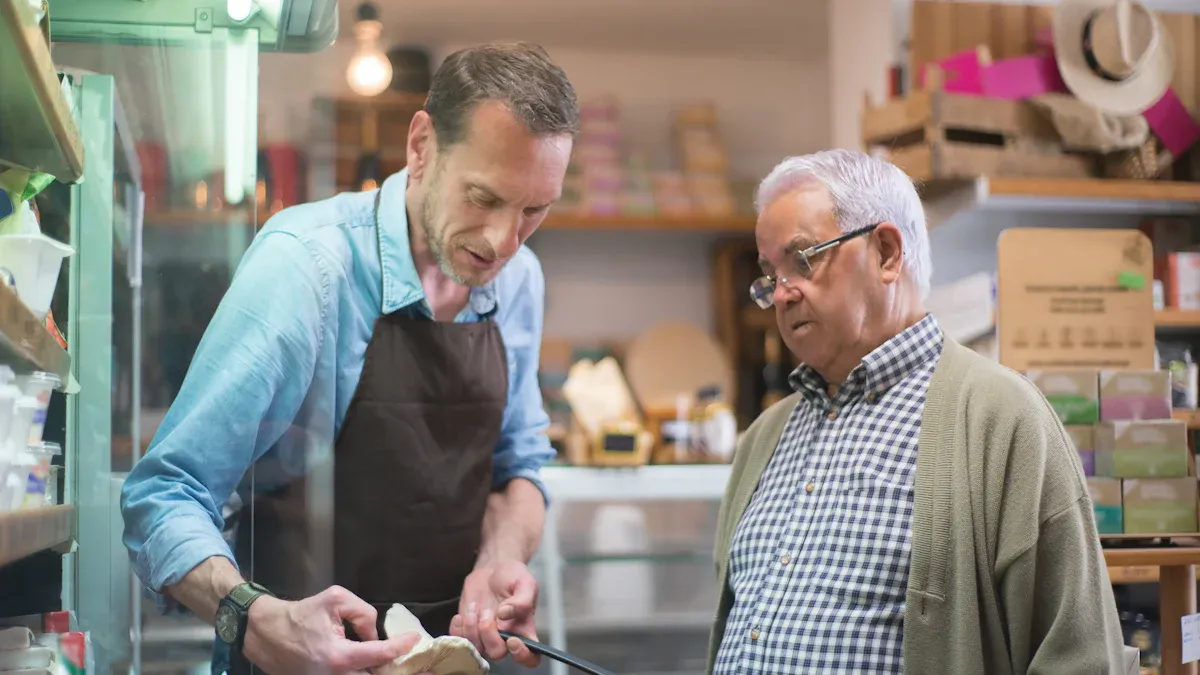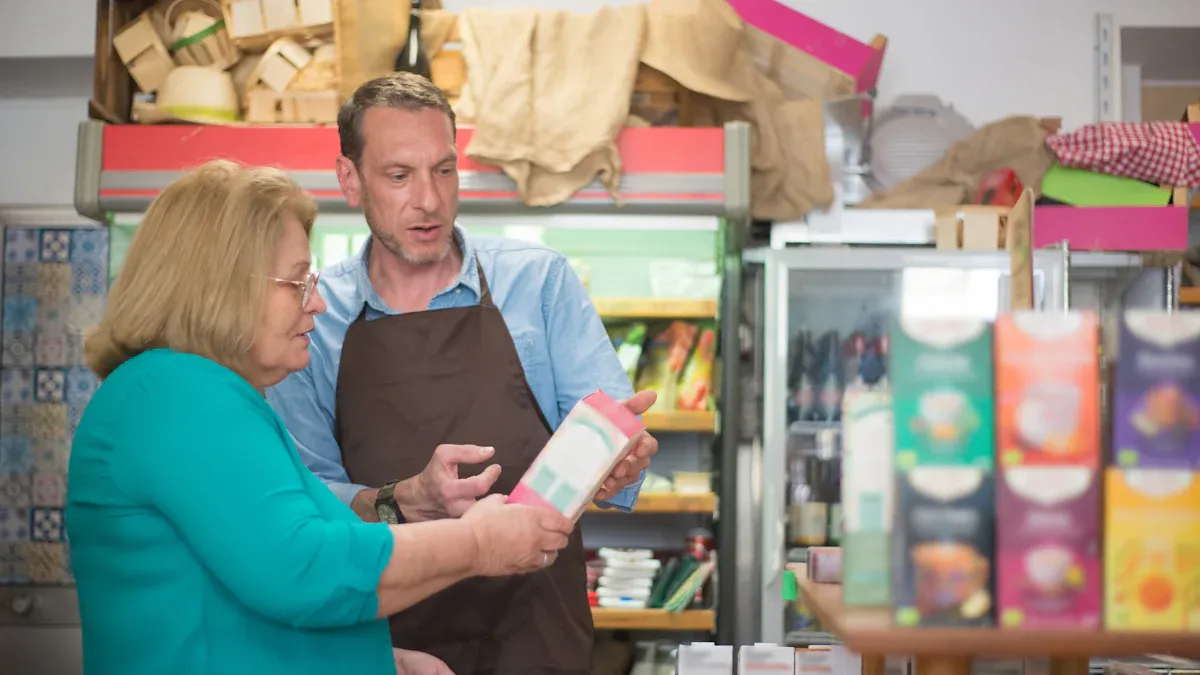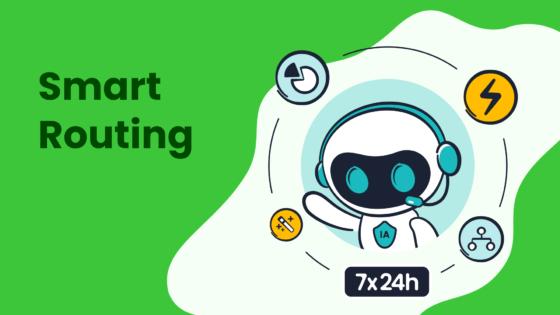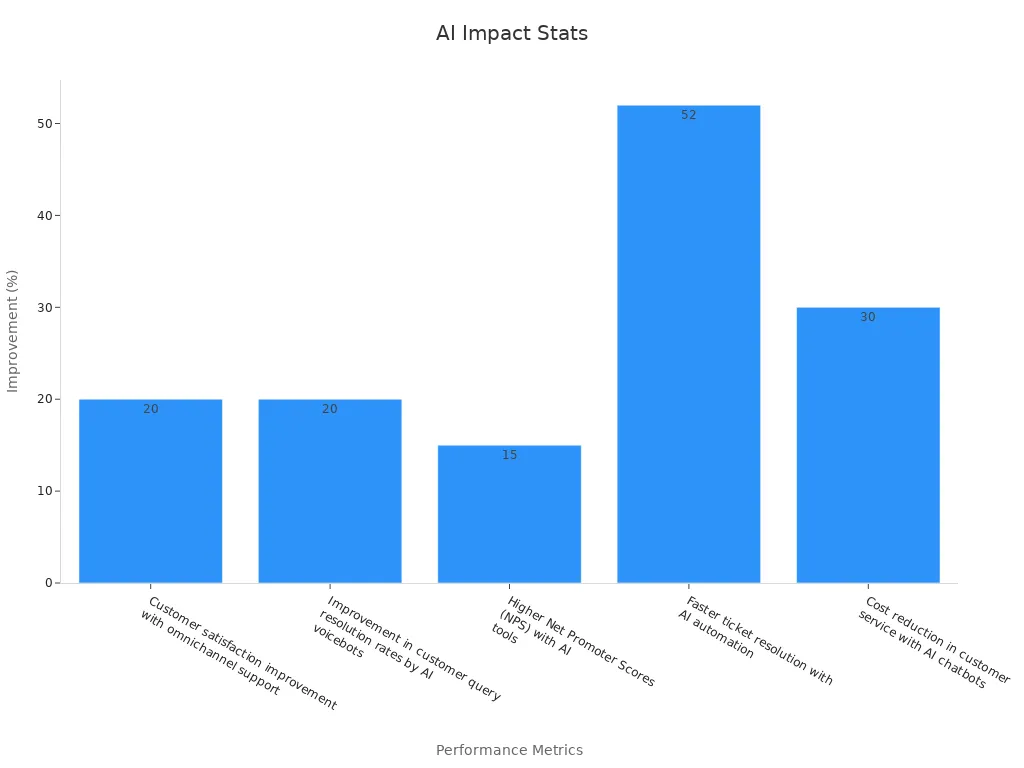Retail Customer Service Tactics That Work Wonders

In the retail industry, customer service is the cornerstone of success. A poor experience can deter customers from returning, while an exceptional one can foster loyalty that lasts for years. This is especially true in customer service in the retail industry, where 96% of consumers emphasize its importance for brand loyalty. Moreover, existing customers tend to spend 67% more than new ones, highlighting the financial benefits of prioritizing shopper satisfaction. Leading companies like Samsung have leveraged Sobot’s innovative platform to achieve a remarkable 97% customer satisfaction rate, demonstrating the power of streamlined service solutions. Outstanding customer service in retail doesn’t just ensure happy customers—it drives repeat business and word-of-mouth recommendations, making it a critical factor for long-term success.
Understanding Customer Expectations in Retail
Understanding what your customers want is the first step to delivering exceptional customer service. When you know their expectations, you can create experiences that keep them coming back. Let’s explore some practical ways to uncover these insights.
Conducting Surveys and Gathering Feedback
Surveys are a fantastic way to hear directly from your customers. Whether it’s a quick online questionnaire or an in-person survey at checkout, these tools help you gather valuable insights. For example:
| Survey Method | Advantages |
|---|---|
| Online Questionnaires | Quick and cost-effective, ideal for reaching a broad audience. |
| Telephone Interviews | Beneficial for gathering comprehensive qualitative insights, engaging less active demographics. |
| In-Person Surveys | Effective in retail settings, allowing timely insights with context to responses. |
| Mobile Surveys | Captures insights at the moment of experience, ensuring timely and relevant feedback. |
Each method has its strengths, so choose the one that fits your goals. Tools like Sobot’s omnichannel solution can help you manage feedback across multiple platforms, ensuring no voice goes unheard.
Using Customer Personas to Anticipate Needs
Creating customer personas is like building a roadmap to better service. These personas represent your typical shoppers, including their preferences, habits, and challenges. For instance, if you know your customers value sustainability, you can stock eco-friendly products. Research shows that many young shoppers are willing to pay more for environmentally-friendly items. By aligning your offerings with their values, you strengthen customer relationships and boost engagement.
Sobot’s CRM tools can help you analyze data and refine these personas. With detailed insights, you can anticipate needs and personalize the customer experience, making every interaction meaningful.
Monitoring Trends in Retail Customer Behavior
Keeping up with trends is crucial for staying relevant. Did you know that 80% of consumers prefer a slower, personalized service over a quick, impersonal one? Or that the line between online and in-store shopping is blurring, creating what’s now called a “phygital” experience?
| Trend Description | Supporting Evidence |
|---|---|
| Demand for personalized experiences | 80% of consumers prefer a good customer service experience that takes longer over a faster one. |
| Interest in sustainability | A majority of young U.S. shoppers are willing to spend more on environmentally-friendly items. |
| Merging of physical and digital shopping | The term 'phygital' describes how consumers do not distinguish between shopping in-store and online. |
| Preference for immersive experiences | 42% of consumers prioritize spending on experiences rather than possessions. |
By tracking these trends, you can adapt your retail strategies to meet evolving expectations. Sobot’s analytics tools make it easy to monitor customer behavior and adjust your approach in real time.
Building a Customer-Centric Culture
Creating a customer-centric culture is essential for delivering exceptional retail experiences. When your team prioritizes customer needs, you build trust, loyalty, and long-term success. Let’s explore how you can foster this mindset within your organization.
Training Employees to Prioritize Customer Needs
Your employees are the face of your brand. Training them to focus on customer needs ensures every interaction leaves a positive impression. Start by teaching them to actively listen and empathize with shoppers. For example, role-playing exercises can help employees practice handling different scenarios.
Data literacy training is another game-changer. When your team understands how to interpret customer data, they can turn insights into actions. This approach empowers them to personalize interactions and resolve issues faster. Tools like Sobot’s unified workspace make it easier for employees to access customer information and deliver tailored solutions.
Fostering a Positive and Supportive Work Environment
A happy team creates happy customers. When employees feel valued, they’re more likely to go the extra mile. Recognize their efforts, celebrate successes, and provide opportunities for growth. For instance, Zappos has built a reputation for its supportive culture, which directly impacts its stellar customer service.
Feedback loops are another powerful tool. Encourage your team to share ideas and suggestions. This not only improves operations but also makes employees feel heard. Centralizing feedback through platforms like Sobot’s omnichannel solution ensures you capture insights from both customers and staff.
Leading by Example with Management Involvement
Leadership sets the tone for a customer-centric culture. When managers actively engage with customers and support their teams, it inspires employees to do the same. For example, Starbucks’ leadership often visits stores to connect with both employees and customers, reinforcing the company’s commitment to service excellence.
Here’s a quick look at best practices for building a customer-centric culture:
| Best Practice | Description |
|---|---|
| Data Literacy Training | Train staff to transform data into actionable insights. |
| Feedback Loops | Use feedback from customers and employees to refine operations. |
| Continuous Innovation | Foster a culture of improvement by encouraging contributions from all levels. |
| Centralized Data Collection | Collect data from various sources to guide decisions and enhance satisfaction. |
| Personalization of Customer Interactions | Tailor interactions to individual preferences to boost loyalty. |
| Customer Loyalty Programs | Offer personalized rewards to encourage repeat business. |
| Continuous Monitoring and Improvement | Commit to ongoing monitoring and refinement to stay competitive. |
By implementing these strategies, you’ll create a customer-centric culture that drives satisfaction and loyalty.
Leveraging Technology to Enhance Retail Customer Service

Technology has transformed how you can connect with your customers. By leveraging the right tools, you can create seamless, personalized experiences that keep shoppers coming back. Let’s dive into three powerful ways technology can elevate your retail customer service.
Personalizing Interactions with CRM Tools
Imagine walking into a store where the staff knows your preferences, past purchases, and even your favorite brands. That’s the magic of CRM (Customer Relationship Management) tools. These systems help you gather and analyze customer data, making it easier to tailor your interactions.
For example, companies like Amazon use CRM tools to recommend products based on purchase history. This approach not only boosts sales but also makes customers feel valued. Similarly, Apple collects feedback through its CRM system to refine its services and products. Here’s how CRM tools can help you:
| Strategy | Description |
|---|---|
| Targeted Marketing | Segment your audience to create campaigns that address specific needs. |
| Feedback Loops | Use customer feedback to improve your services and meet expectations. |
With tools like Sobot’s unified workspace, you can centralize customer data and provide personalized experiences effortlessly. This not only enhances customer satisfaction but also builds loyalty over time.

Using AI-Powered Solutions like Sobot's Voice/Call Center
AI-powered solutions are revolutionizing retail customer service. They help you handle inquiries faster, reduce costs, and improve overall efficiency. Sobot’s Voice/Call Center is a prime example of how AI can transform your operations. Here’s what it offers:
- Smart Call Routing: Automatically direct calls to the right agent or department, saving time for both you and your customers.
- AI-Powered Voicebot: Handle repetitive queries with ease, allowing your team to focus on complex issues.
- Real-Time Monitoring: Track call data and agent performance to identify areas for improvement.
The results speak for themselves. Businesses using AI tools like Sobot’s Voice/Call Center have seen a 20% improvement in customer satisfaction and a 52% faster ticket resolution rate. Plus, AI automation can reduce customer service costs by 30%. These numbers highlight why integrating AI into your retail customer service strategies is a game-changer.

Implementing Chatbots for 24/7 Support
Your customers expect support whenever they need it, not just during business hours. That’s where chatbots come in. These AI-powered tools provide instant assistance, ensuring your customers never have to wait. Here’s why chatbots are a must-have for online customer service:
| Benefit | Description |
|---|---|
| Enhanced Customer Experience | Immediate responses reduce frustration and boost satisfaction. |
| Reduced Waiting Times | Customers get help anytime, increasing loyalty and retention. |
| Consistent Quality of Answers | Chatbots deliver accurate responses, even during peak times. |
| Scalability of Support | Handle high service volumes efficiently without extra costs. |
Retailers like Sephora use chatbots to offer personalized recommendations, while Amazon Go combines them with other technologies for a seamless shopping experience. Sobot’s AI-powered chatbot takes this a step further by integrating with your existing systems, providing multilingual support, and offering 24/7 availability. This ensures your customers always receive the help they need, no matter when they shop.
Improving the Retail Customer Experience
Creating a memorable retail customer experience is all about making your customers feel valued and comfortable. From the moment they step into your store to the time they leave, every detail matters. Let’s explore how you can elevate their experience and keep them coming back.
Creating a Welcoming and Organized Store Layout
Have you ever walked into a store and felt overwhelmed by clutter or confusion? You’re not alone. A disorganized store can drive customers away. In fact:
- 64% of shoppers leave without buying anything if the store feels chaotic or hard to navigate.
- Optimizing your layout can boost sales by up to 15% by making products easier to find.
Start by designing a layout that flows naturally. Use clear signage to guide customers and place popular items in high-traffic areas. This encourages exploration and makes shopping more enjoyable. An organized space also reduces congestion, allowing everyone to move around comfortably.
Think about the in-store experience as a journey. When customers can easily find what they need, they’re more likely to stay longer and make repeat visits. A well-thought-out layout isn’t just about aesthetics—it’s a powerful tool for improving the retail customer experience.
Offering Seamless Omnichannel Shopping Options with Sobot's Omnichannel Solution
Today’s shoppers expect flexibility. They want to browse online, pick up in-store, or even chat with customer service through social media. This is where omnichannel shopping comes in. It bridges the gap between online and offline experiences, creating a unified journey for your customers.
Sobot’s Omnichannel Solution makes this process effortless. It integrates all your communication channels—email, social media, live chat, and more—into one platform. This means your customers can switch between channels without repeating themselves. For example, a shopper might start by browsing your website, ask a question via live chat, and then complete their purchase in-store. With Sobot, every interaction feels seamless.
This approach doesn’t just improve convenience. It also builds trust and loyalty. When customers see that you’re willing to meet them wherever they are, they’re more likely to return. Plus, Sobot’s analytics tools help you track these interactions, giving you valuable insights to refine your strategy.
Providing Clear and Accessible Product Information
Imagine trying to buy a product but struggling to find details about it. Frustrating, right? Clear and accessible product information is essential for a positive retail customer experience. Whether it’s price, features, or availability, your customers need this information to make confident decisions.
Start by ensuring your product labels are easy to read. Use digital displays or QR codes to provide additional details, like reviews or usage tips. Online, make sure your website is mobile-friendly and includes comprehensive descriptions. Did you know that 88% of consumers research products online before buying in-store? This highlights the importance of consistency across all platforms.
Sobot’s AI-powered chatbot can assist here. It provides instant answers to customer queries, ensuring they always have the information they need. Whether they’re shopping online or in-store, this tool enhances their experience by removing barriers to purchase.
By focusing on these three areas, you’re not just improving retail customer service—you’re creating an environment where customers feel valued and understood. And that’s the key to long-term success.
Handling Complaints Effectively
No matter how great your customer service is, complaints are inevitable. What sets you apart is how you handle them. Addressing complaints effectively can turn unhappy customers into loyal advocates. Let’s explore how you can master this skill.
Training Staff to Respond Calmly and Professionally
When a customer complains, emotions often run high. Your staff needs to stay calm and professional to de-escalate the situation. Train them to listen actively, acknowledge the issue, and respond with empathy. For example, instead of saying, “That’s not our fault,” they could say, “I understand how frustrating this must be. Let me help you resolve it.”
Role-playing exercises can prepare your team for real-life scenarios. Equip them with tools like Sobot’s unified workspace, which provides instant access to customer history. This helps your staff offer personalized solutions quickly, leaving a positive impression.
Using Complaints as Opportunities for Improvement
Complaints aren’t just problems—they’re opportunities for improvement. Each one highlights a gap in your service or product that you can address. Did you know that 70% of unhappy customers who have their complaints resolved are more likely to stay loyal? By resolving issues promptly, you not only retain customers but also build trust.
Encourage your team to document complaints and analyze patterns. For instance, if multiple customers mention unclear product instructions, it’s a sign to revise them. Tools like Sobot’s analytics can help you track these trends and implement changes effectively. Remember, every resolved complaint is a step toward better customer satisfaction.
Following Up to Ensure Customer Satisfaction
Resolving a complaint is just the first step. Following up shows your customers that you genuinely care. A simple email or call asking, “Is everything okay now?” can make a big difference. Personalized responses make customers feel valued, while systematic follow-ups ensure no feedback slips through the cracks.
Continuous monitoring of satisfaction metrics is also crucial. Use tools like Sobot’s omnichannel solution to track these metrics and close the loop with customers. For example, if you’ve made changes based on their feedback, let them know. This transparency fosters loyalty and encourages repeat business.
Tip: Customers with successfully resolved complaints are not only more likely to stay but also tend to spend more, according to a Harvard Business Review study.
By training your staff, learning from complaints, and following up, you can transform challenges into opportunities. Effective complaint handling isn’t just about fixing problems—it’s about building lasting relationships.
Implementing Loyalty Programs for Customer Retention

Loyalty programs are a powerful way to strengthen customer retention and build customer loyalty. They create a sense of belonging and reward customers for their continued support, encouraging repeat purchases and long-term relationships. Let’s explore how you can design effective loyalty programs that keep your customers coming back.
Offering Rewards for Repeat Purchases
Rewards motivate customers to return. Whether it’s discounts, points, or free products, they make shoppers feel appreciated. Research shows that 81% of customers are more likely to stick with brands offering loyalty programs. Even a small 5% increase in retention can boost profits by up to 95%.
To maximize engagement, simplify the redemption process. For example, Starbucks allows customers to redeem points for free drinks directly through its app. This convenience enhances the redemption rate and keeps customers coming back. Tools like Sobot’s omnichannel solution can help you track metrics like redemption rates and repeat purchase rates, ensuring your program delivers results.
| Metric | Description |
|---|---|
| Redemption Rate | Measures the percentage of rewards redeemed, reflecting customer satisfaction. |
| Repeat Purchase Rate (RPR) | Calculates the percentage of customers making multiple purchases, showing loyalty dynamics. |
| Average Order Value | Tracks spending behavior to assess program impact. |
Personalizing Offers Based on Customer Preferences
Personalization is key to building customer loyalty. Tailored offers show customers you understand their needs, making them feel valued. For instance, Sephora’s loyalty program uses purchase history to recommend products and offer exclusive discounts. This approach increases engagement and drives repeat business.
Sobot’s CRM tools can help you analyze customer data and create personalized rewards. By segmenting your audience, you can offer targeted promotions that resonate with individual preferences. Did you know emotionally engaged customers spend twice as much on brands they’re loyal to? Personalization isn’t just a nice touch—it’s essential for customer retention.
Tip: Use customer feedback to refine your offers. Happy customers are 70% more likely to try new products and spend 31% more than first-time buyers.
Promoting Exclusive Benefits for Loyal Customers
Exclusive benefits make loyalty programs irresistible. Discounts, early access to sales, and VIP perks create a sense of value that keeps customers loyal. Studies show that satisfaction with loyalty card benefits correlates positively with overall customer loyalty.
For example, Amazon Prime offers free shipping and exclusive deals, making members feel special. Sobot’s unified workspace can help you identify your most loyal customers and offer tailored benefits. By rewarding loyalty, you not only retain customers but also increase their lifetime value—6.3 times higher for those who actively use loyalty points.
| Study Reference | Findings |
|---|---|
| Kumar et al., 2016 | Discounts and points accumulation enhance loyalty. |
| Evans et al., 2018b | Exclusive offers create a sense of value and motivate repeat purchases. |
Loyalty programs aren’t just about rewards—they’re about building relationships. When customers feel valued, they’ll keep coming back, boosting your customer retention and driving long-term success.
Empowering Employees to Deliver Exceptional Service
Providing Ongoing Training and Development
Your employees are the backbone of your retail customer service. When they feel confident and well-prepared, they deliver exceptional experiences. Ongoing training isn’t just a nice-to-have—it’s a must. Here’s why:
- Empowered employees lead to higher satisfaction and engagement scores.
- Better training reduces turnover, saving costs and maintaining team continuity.
- Well-trained staff improve customer satisfaction (CSAT) and loyalty, boosting Net Promoter Scores (NPS).
- Technology and training equip employees to handle complex customer interactions effectively.
For example, enhancing product knowledge helps your team engage customers better, leading to repeat purchases. Interactive methods like e-learning or gamified training keep employees motivated and ensure they retain what they learn. Regular workshops and webinars also keep them updated on industry trends. Tools like Sobot’s unified workspace can simplify training by providing easy access to customer data and insights, helping your team deliver personalized service every time.
Encouraging Autonomy in Decision-Making
Micromanaging your team can stifle creativity and slow down service. Instead, empower your employees to make decisions on the spot. When they have the freedom to resolve issues independently, they can act faster and build stronger customer relationships.
For instance, imagine a customer needing a quick exchange. If your employee doesn’t have to wait for managerial approval, the process becomes seamless. This autonomy not only improves the customer experience but also boosts employee confidence. Sobot’s AI-powered tools, like its Voice/Call Center, can support this by providing real-time data and insights, enabling your team to make informed decisions without hesitation.
Tip: Trust your team to handle small challenges. It shows you value their judgment and encourages them to take ownership of their roles.
Recognizing and Rewarding Outstanding Performance
Recognition is a powerful motivator. When you celebrate your employees’ achievements, you inspire them to go above and beyond. Companies with recognition-rich cultures see up to 31% lower turnover rates, which means happier teams and better service quality.
| Benefit Type | Description |
|---|---|
| Morale Boost | Recognition improves employee morale, creating a more positive work environment. |
| Employee Retention | Lower turnover rates save costs and maintain service consistency. |
| Unified Culture | Recognition aligns teams across locations, enhancing overall service quality. |
Simple gestures like “Employee of the Month” awards or shoutouts during team meetings can make a big difference. You can also use performance metrics from tools like Sobot’s analytics to identify top performers and reward them with bonuses or extra perks. When your team feels valued, they’ll deliver the kind of service that keeps customers coming back.
Note: Happy employees create happy customers. Investing in your team is an investment in your business’s success.
Measuring and Continuously Improving Performance
Delivering exceptional customer service isn’t a one-time effort. It’s an ongoing process that requires you to measure, review, and refine your strategies. By tracking the right metrics and celebrating successes, you can ensure continuous improvement in your retail operations.
Tracking Key Customer Service Metrics
Metrics are your roadmap to better customer service. They show you what’s working and where you need to improve. Here’s a quick look at some key metrics you should track:
| Metric | Description |
|---|---|
| Customer Satisfaction Score | Measures customer satisfaction out of 100. |
| Net Promoter Score | Measures customer’s desire to promote your business. |
| Customer Effort Score | Measures how difficult it is for a customer to do business with a company. |
| Customer Retention Rate | Measures the rate at which you are retaining customers. |
| Customer Churn Rate | Measures the rate at which you’re churning customers. |
| Time to Resolution | Measures the amount of time it takes an agent to resolve a support ticket. |
| First Contact Resolution | Measures the proportion of first responses that solve support tickets. |
Tracking these metrics helps you identify trends and areas for improvement. For example, if your Customer Effort Score is low, it might be time to simplify your processes. Tools like Sobot’s analytics platform make it easy to monitor these metrics in real time, giving you actionable insights to enhance your customer service.
Regularly Reviewing and Adjusting Strategies
Improvement doesn’t happen by accident. You need to regularly review your strategies to ensure they align with customer expectations. Start by analyzing your metrics. If your Net Promoter Score is dropping, ask yourself why. Are customers facing delays? Are your agents overwhelmed?
Once you identify the issue, adjust your approach. For instance, if your First Contact Resolution rate is low, consider training your team to handle inquiries more effectively. Sobot’s Voice/Call Center can help here by providing smart call routing and AI-powered voicebots, ensuring customers get the right support quickly. Regular reviews keep your strategies fresh and effective, helping you stay ahead in the competitive retail landscape.
Tip: Schedule monthly strategy reviews to catch issues early and maintain high customer satisfaction.
Celebrating Successes and Addressing Weaknesses
Don’t forget to celebrate your wins! When your team achieves a high Customer Satisfaction Score or reduces Average Handle Time, acknowledge their efforts. Recognition boosts morale and motivates your employees to keep delivering exceptional service.
At the same time, address weaknesses openly. If your Customer Retention Rate is slipping, involve your team in brainstorming solutions. Use tools like Sobot’s unified workspace to analyze customer feedback and identify pain points. By balancing celebration with constructive action, you create a culture of continuous improvement that drives long-term success.
Note: Success isn’t just about fixing problems—it’s about building a team that’s always striving to do better.
Delivering exceptional retail customer service isn’t just about meeting expectations—it’s about exceeding them. From understanding customer needs to empowering your team and leveraging technology, every strategy plays a role in creating happy customers who keep coming back. Tools like Sobot’s Voice/Call Center and Omnichannel Solution simplify these efforts, helping you personalize interactions, streamline communication, and boost satisfaction.
Consider the impact of these tactics. Businesses using chatbots and WhatsApp Business API have reduced response times by three hours and increased satisfaction ratings by 25%. Carrefour Kenya eliminated physical queues, boosting sales, while Saudi Business Center cut wait times by 30%, enhancing customer experiences. These examples show how prioritizing customer satisfaction drives loyalty and long-term success.
By implementing these strategies, you’ll not only improve operations but also foster trust and loyalty. Happy customers are the foundation of thriving retail businesses, and with Sobot’s tools, you’re equipped to deliver excellence every step of the way.
FAQ
What is the best way to improve retail customer service?
Focus on understanding your customers’ needs. Use tools like Sobot’s Omnichannel Solution to unify communication channels and provide seamless support. For example, businesses using omnichannel strategies retain 89% of their customers, compared to 33% for those without.
How can technology help with customer complaints?
Technology simplifies complaint resolution. Sobot’s Voice/Call Center offers features like smart call routing and AI-powered voicebots to handle issues faster. This reduces resolution time by up to 52%, ensuring happier customers and fewer escalations.
Why is personalization important in retail?
Personalization makes customers feel valued. For instance, 80% of shoppers are more likely to buy from brands offering tailored experiences. Sobot’s CRM tools help you analyze customer data and deliver personalized interactions that boost loyalty.
How do loyalty programs benefit retail businesses?
Loyalty programs encourage repeat purchases. Research shows that 81% of customers stick with brands offering rewards. Sobot’s analytics tools can track redemption rates and help you design programs that maximize engagement and retention.
Can small businesses afford advanced customer service tools?
Absolutely! Sobot’s solutions, like its SaaS-based Voice/Call Center, are cost-effective and scalable. They’re perfect for small businesses looking to enhance customer interactions without breaking the bank.
See Also
Excelling at Live Chat Within Retail Businesses
Ten Strategies to Enhance Live Chat Customer Experience
Enhance Live Chat Effectiveness in Retail Settings
